聚合诱导发射钌(II)复合纳米材料:碱性磷酸酶活性和抑制剂的磷光测定
IF 4.9
2区 化学
Q1 CHEMISTRY, ANALYTICAL
引用次数: 0
摘要
碱性磷酸酶(ALP)是一种重要的蛋白质催化剂,在调节整个生物体的蛋白质代谢和功能中起着核心作用,是治疗人类疾病的可靠基础。因此,开发一种灵敏、选择性的ALP检测策略具有重要的科学和现实意义。本研究选择SiO2作为载体包封Ru-1发光团,有效防止Ru-1分子泄漏。同时,在制备过程中,劣质溶剂的引入诱导Ru-1分子聚集成纳米颗粒,从而通过聚集诱导发射效应增强发射。此外,利用原位生长方法,我们开发了一种基于Ru-SiO2-MnO2纳米复合材料的磷光检测策略。l-抗坏血酸(AA)可由ALP催化l-抗坏血酸-2-磷酸钠(AAP)水解生成。这一过程进一步分解二氧化锰,并通过“开启”机制触发磷光传感器。此外,利用Na3VO4抑制ALP活性的能力,该磷光法进一步用于ALP抑制剂的鉴定。在优化的实验条件下,磷光强度与ALP浓度在0.05 ~ 17 U/L范围内呈线性相关,检出限低至0.031 U/L。该策略消除了复杂的洗涤或修饰过程,避免了传统有机染料聚集引起的猝灭现象,从而成为一种简单、经济的ALP“开启”磷光检测方法。该方法在血清样品分析中也表现出优异的适用性。本文章由计算机程序翻译,如有差异,请以英文原文为准。

Aggregation-induced emission Ru(II) complex nanomaterials: Phosphorescent determination of alkaline phosphatase activity and inhibitors
Alkaline phosphatase (ALP) is a vital protein catalyst that holds a central role in modulating protein metabolism and function throughout organisms, and serves as a reliable foundation for the treatment of human diseases. Thus, the development of a sensitive and selective detection strategy for ALP is considerable scientific and practical significance. In this study, SiO2 was chosen as the carrier for encapsulating Ru-1 luminophores to effectively prevent the leakage of Ru-1 molecules. Meanwhile, during the preparation process, the introduction of a poor solvent induces aggregation of Ru-1 molecules into nanoparticles, thereby enhancing emission through the aggregation-induced emission effect. Furthermore, using an in-situ growth method,we developed a phosphorescence-based detection strategy, which builds on Ru-SiO2-MnO2 nanocomposites. l-ascorbic acid (AA) can be generated by ALP, which catalyzes the hydrolysis of sodium L-ascorbyl-2-phosphate (AAP). This process further breaks down MnO2 and triggers the phosphorescence sensor through a “turn-on” mechanism. Moreover, by exploiting the capacity of Na3VO4 to suppress ALP activity, this phosphorescent method was further employed for the identification of ALP inhibitors. Under the optimized experimental conditions, the phosphorescent intensity displayed a linear association with ALP concentrations ranging from 0.05 to 17 U/L, while the limit of detection was as low as 0.031 U/L. The proposed strategy eliminates the need for complex washing or modification procedures and avoids the aggregation-caused quenching phenomenon of traditional organic dyes, thus standing out as an uncomplicated, economical “turn-on” phosphorescent detection method for ALP. This approach also demonstrated excellent applicability in the analysis of serum samples.
求助全文
通过发布文献求助,成功后即可免费获取论文全文。
去求助
来源期刊

Microchemical Journal
化学-分析化学
CiteScore
8.70
自引率
8.30%
发文量
1131
审稿时长
1.9 months
期刊介绍:
The Microchemical Journal is a peer reviewed journal devoted to all aspects and phases of analytical chemistry and chemical analysis. The Microchemical Journal publishes articles which are at the forefront of modern analytical chemistry and cover innovations in the techniques to the finest possible limits. This includes fundamental aspects, instrumentation, new developments, innovative and novel methods and applications including environmental and clinical field.
Traditional classical analytical methods such as spectrophotometry and titrimetry as well as established instrumentation methods such as flame and graphite furnace atomic absorption spectrometry, gas chromatography, and modified glassy or carbon electrode electrochemical methods will be considered, provided they show significant improvements and novelty compared to the established methods.
 求助内容:
求助内容: 应助结果提醒方式:
应助结果提醒方式:


